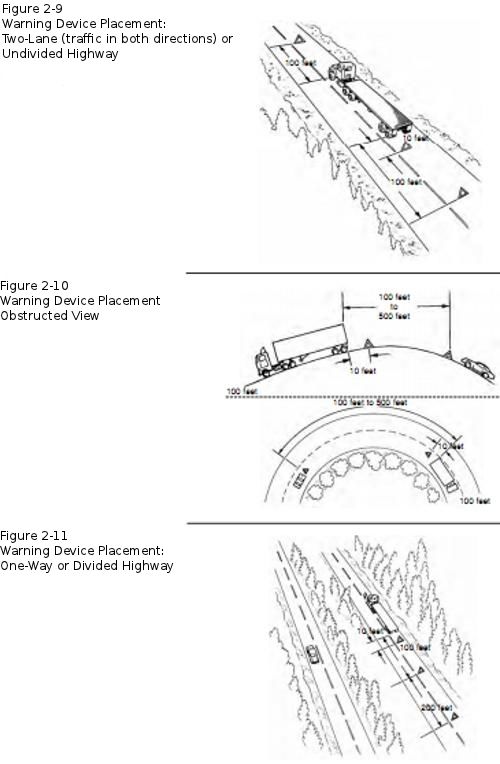Review Questions - Click On The Picture To Begin...

- Using turn signals
- Using emergency flashers
- Flashing lights
- Honking a horn
Quote From The CDL Manual:
Use your horn only when needed - Your horn can let others know you are there and help to avoid a crash. Use your horn when needed; however, it can startle others and could be dangerous when used unnecessarily.
- 5 minutes
- 30 minutes
- 10 minutes
- 20 minutes
Quote From The CDL Manual:
If you must stop on a road or the shoulder of any road, you must put out your emergency warning devices within 10 minutes.
TruckingTruth's Advice:
Pay special attention to this and memorize it. There is a good chance this question will show up on your written exam.
- 10 feet, 100 feet, and 200 feet in front of the vehicle
- 100 feet in front of the vehicle and 500 feet and 1,000 feet behind the vehicle
- Within 10 feet of the front or rear corners of the vehicle and 100 feet behind and ahead of the vehicle
- 10 feet, 100 feet and 200 feet to the rear of your vehicle
Quote From The CDL Manual:
On a two-lane road carrying traffic in both directions or on an undivided highway, place warning devices within 10 feet of the front or rear corners to mark the location of the vehicle and 100 feet behind and ahead of the vehicle, on the shoulder or in the lane you are stopped in.
TruckingTruth's Advice:
It is extremely important to memorize proper warning device placement for different conditions (undivided highway, divided highway, and when obstructions are present). There is a very good chance a question regarding warning device placement will show up on your written exam.
- Hold them between yourself and the oncoming traffic
- Hold them behind you
- Hold them at your sides
- Carry them under your arm
Quote From The CDL Manual:
When putting out the triangles, hold them between yourself and the oncoming traffic for your own safety (so other drivers can see you).
- 100 feet behind the vehicle
- 200 feet behind the vehicle
- 100 feet in front of the vehicle
- 10 feet behind the vehicle
Quote From The CDL Manual:
On or by a one-way or divided highway, place warning devices 10 feet, 100 feet and 200 feet toward the approaching traffic.
TruckingTruth's Advice:
Be sure to memorize how to place your warning devices during different situations. This is something that will very likely show up on your written test.
- A warning device should be placed beyond the obstruction if it is 100 to 500 feet from your vehicle
- All 3 warning devices should be placed beyond the obstruction
- Warning devices should be placed closer to your vehicle if an obstruction is present
- Obstructions should have no bearing on where warning devices are placed
Quote From The CDL Manual:
A warning device should be placed back beyond any hill, curve or other obstruction that prevents other drivers from seeing the vehicle within 500 feet.
TruckingTruth's Advice:
It's very important to memorize where to place warning devices for different situations as this will very likely show up on your written exam. Please take a moment to review this section in your CDL manual and memorize the requirements for each situation.








 TT On Facebook
TT On Facebook